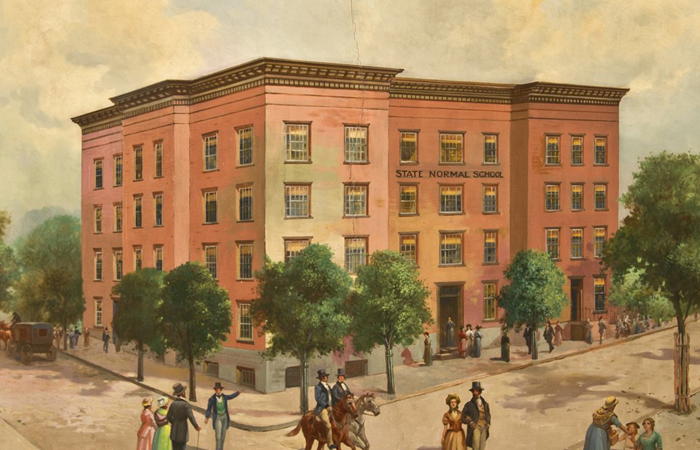Collections : [University Archives]
University Archives
Records that document the history of the University at Albany, SUNY and its predecessor schools.
Search Constraints
Start Over You searched for: Online Content Online Content Remove constraint Online Content: Online Content Collecting Area University Archives Remove constraint Collecting Area: University ArchivesSearch Results
Student Success Stories Podcasts, 2019-2020 6 Digital Files
Faculty Handbooks Collection, 1948-1994 0.8 cubic ft.
Faculty Reference Collection, 1845-present 42.25 cubic ft.
General Electric- Non-Project Cirrus, 1891-1993 21.0 cubic ft.
The research laboratory at General Electric was the launching pad for some of Vincent Schaefer's most pivotal scientific work. This series contains research notes, photographs, reports (published and unpublished, internal and external), and correspondence relating to all of his more famous experiments as well as a range of lesser-known work accomplished during his years at the G.E. Research Laboratory in Schenectady. The materials cover topics such as smoke/artificial fog generation, surface chemistry, studies of ice and snow particles, and early cloud seeding. The series is divided according to areas of specific interest to Schaefer as well as correspondence and publications.
Vincent J. Schaefer Papers, 1891-1993 135 cubic ft.
The formation and behavior of snow and ice crystals were a lifelong interest of Schaefer's, and in his time at General Electric he was able to focus on the subject during the World War II years as ice related to the safety of U.S. Air Force planes. Schaefer and Irving Langmuir's interest in that topic grew as a result of their World War II-era contract work with the military, and the experiments they conducted after the war's end led directly to their Project Cirrus contract in 1947—an undertaking so extensive that their work in that area merited its own series in this collection. Much of their foundational work in snow and ice composition and behavior was grounded in observations and experiments conducted on Mount Washington in New Hampshire. Schaefer discovered during this time that ice crystals and snowflakes could be captured and observed using Formvar plastic. Using this method, he documented very specific data about ice and snow before creating some of the first replicas of specific snowflake shapes. The work of Schaefer and his colleagues regarding ice research includes handwritten notes, drawings, charts, photographs, reports, and correspondence specific to ice, snow, and Mount Washington.
Institute For Humanistic Studies Records, 1977-1980 3.33 cubic ft.
Director's Conference Correspondence, 1977-1980 1.5 cubic ft.
Contains correspondence with potential speakers, funding and annual financial reports, brochures, newspaper and journal clippings relating to three international conferences: "Helios: From Myth to Solar Energy," 16-18 March, 1978; "Apollo Agonistes: The Humanities in a Computerized World," 19-21 April, 1979; "Asclepius at Syracuse: Thomas Szasz, Libertarian Humanist," 17-19 April, 1980. Also includes correspondence and program related material for a planned local lecture series of 14 dates titled, "Thanatos: Perspectives on Death," which was to be held from the fall of 1979 through the winter of 1980. The Conference was never held.
Institute of Gerontology Records, 1968-1995 11.6 cubic ft.
Lillian Coons Papers, 1935-2019 1.5 cubic ft.
First volume scrapbook from the Lillain Coons collection. Created by Lillain during her Freshman year, containing schoolwork, pamphlets, programs, letters, personal notes, and newspaper clippings.
Second volume scrapbook from the Lillain Coons collection. Created by Lillain during her Sophomore year, containing schoolwork, pamphlets, programs, letters, personal notes, and newspaper clippings.
Louis Ismay Papers, 1959-1977 29.14 cubic ft.
Student Writings, 1969-1977, Undated 11.75 cubic ft.
The projects of students in the Environmental Forum that were kept by Lou Ismay can be found in this series. The projects are filed in alphabetical order by name of student. Journals, student papers, student project reports, and student autobiographies are part of this series. The papers are on a range of environmental issues with many relating to recycling and other relevant projects done around campus and the Capital Region. Photographs and slides that accompany student papers were kept together with the papers. Oversized material is filed separately and includes 4 posters and other oversized projects. Audiovisuals for student projects are also in the series, including 11 audiocassette tapes and 1 reel-to-reel audiotape.
Martin Fausold Papers, 1919, 1945-2008 10.39 cubic ft.
The second series of this collection consists of Fausold's research and subject files. A majority of this series are research materials for the Oral History of SUNY Project. These materials include a large number of dissertations, newspaper articles, and multiple finding aides to archival collections, some annotated by Fausold. There are also multiple copies of Fausold's Draft History of the State University of New York as well as executive committee meeting minutes and membership lists. Fausold's applications and acceptance letters into the Research Foundation and Visiting Professorships' GRI Program can be found in this series. Fausold also kept records of Research Foundation expenses, correspondence, and funding possibilities. This series also contains Fausold's correspondence from the 1980s to the 2000s about the Oral History of SUNY Project.
